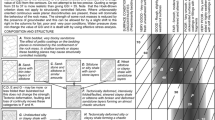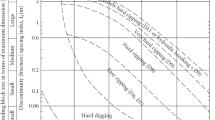Abstract
In the present study a new classification method for the assessment of ease of excavation of rock masses is proposed, based on the Geological Strength Index and the point load strength of the intact rock. The data originate from excavation sites in Greece in sedimentary and metamorphic rock masses. A wide variety of rock structures were considered, ranging from blocky to disintegrated, and different excavation methods have been used (blasting, hydraulic breaking, ripping and digging). The proposed method cannot be applied to heterogeneous rock masses and soft rocks/hard soils.













Similar content being viewed by others
References
Abdullatif OM, Cruden DM (1983) The relationship between rock mass quality and ease of excavation. Bull Eng Geol Environ 28:183–187
Atkinson T (1971) Selection of open pit excavating and loading equipment. Trans Inst Min Metall 80:A101–A129
Barton N, Lien R, Lunde J (1974) Engineering classification of rock masses for the design of tunnel support. Norwegian Geotechnical Institute Publication, Oslo, pp 4–15
Basarir H, Karpuz C (2004) A rippability classification system for marls in lignite mines. Eng Geol 74:303–318
Bell FG (2004) Engineering geology and construction. Taylor and Francis Group, London, p 791
Bieniawski ZT (1974) Geomechanics classification of rock masses and its application to tunelling. In: Proceedings of the 3rd Congress of I.S.R.M., Denver 1:27–32
Bieniawski ZT (1975) The point-load test in geotechnical practice. Eng Geol 9:1–11
Cai M, Kaiser PK, Uno H, Tasaka Y, Minami M (2004) Estimation of rock mass deformation modulus and strength of jointed hard rock masses using the GSI system. Int J Rock Mech Min Sci 41:3–19
Caterpillar TC (2001) Caterpillar performance handbook. Caterpillar Inc., Preoria
Church HK (1981) Excavation handbook. McGraw-Hill Inc., New York
Duncan N (1969) Engineering geology and rock mechanics, vol 2. Leonard Hill, London
Fowell RJ, Johnson ST (1982) Rock Classification and assessment for rapid excavation. In: Farmer IW (ed) Proceedings of Symposium on Strata Mechanics. Elsevier, New-York, pp 241–244
Franklin JA, Broch E, Walton G (1971) Logging the mechanical character of rock. Trans Inst Min Metall 80:A1–A9
Gurocak Z, Alemdag S, Zaman MM (2008) Rock slope stability and excavatability assessment of rocks at the Kapikaya dam site, Turkey. Eng Geol 96(1–2):17–27
Hadjigeorgiou J, Poulin R (1998) Assessment of ease of excavation of surface mines. J Terramech 35:137–153
Hawkins AB (2000) General report: the nature of hard rocks/soft soils. The Geotechnics of Hard Soils—Soft Rocks. In: Evangelista A, Picarelli L (eds) Rotterdam, Balkema, pp 1391–1402
Hoek E (1994) Strength of rock and rock masses. ISRM News J 2(2):4–16
Hoek E, Karzulovic A (2000) Rock mass properties for surface mines. Slope Stability in Surface Mining. In: Hustralid WA, McCarter MK, van Zyl DJA (eds) Littleton, Colorado: Society for Mining, Metallurgical and Exploration (SME), pp 59–70
Hoek E, Wood D, Shah S (1992) A modified Hoek—Brown criterion for jointed rock masses. In: Proceedings of Rock Characterization, Symposium on International Society of Rock Mechanics: Eurock’92. Hudson JA (ed) British Geotechnical Society, London, pp 209–214
Hoek E, Kaiser PK, Bawden WF (1995) Support of underground excavations in hard rock. Rotterdam, Balkema
Hoek E, Marinos P, Benissi M (1998) Applicability of the Geological Strength Index (GSI) classification for very weak and sheared rock masses. The case of the Athens Schist Formation. Bull Eng Geol Environ (IAEG) 57(2):151–160
International Society for Rock Mechanics ISRM (1981) Rock characterization, testing and monitoring. In: Brown ET (ed) ISRM suggested methods. Pergamon Press, Oxford, p 211
International Society for Rock Mechanics ISRM (1985) Point load test, suggested method for determining point load strength. Int J Rock Mech Min Sci and Geomech Abstr 22:51–60
Karpuz C (1990) A classification system for excavation of surface Coal Measures. Min Sci Technol 11:157–163
Kentli B, Topal ΖT (2004) Evaluation of rock excavatability and slope stability along a segment of motorway, Pozanti, Turkey. Environ Geol 46:83–95
Kirsten HAD (1982) A classification system for excavation in natural materials. Civ Eng S Afr 24:293–308
MacGregor F, Fell R, Mostyn GR, Hocking G, Nally G (1994) The estimation of rock rippability. Q J Eng Geol 27:123–144
Marinos P, Hoek E (2000) GSI: A geologically friendly tool for rock mass strength estimation. In: Proceedings of GeoEng2000 Conference, Melbourne, 1:1422–1446
Marinos P, Hoek E (2001) Estimating the geotechnical properties of heterogeneous rock masses such as flysch. Bull Eng Geol Environ (IAEG) 60:85–92
Marinos P, Marinos V, Hoek E (2007) Geological Strength Index (GSI). A characterisation tool for assessing engineering properties for rock masses. In: Romana, Perucho, Olalla (eds) Underground works under special conditions. Taylor and Francis, Lisbon, pp 13–21
McLean AC, Gribble CD (1985) Geology for Civil Engineers, 2nd edn edn. George Allen and Unwin, Australia, p 314
Palmström A (2000) Recent developments in rock support estimates by the RMi. J Rock Mech Tunnell Techn 6(1):1–19
Pettifer GS, Fookes PG (1994) A revision of the graphical method for assessing the excavability of rock. Q J Eng Geol 27:145–164
Scoble MJ, Muftuoglu YV (1984) Derivation of a diggability index for surface mine equipment selection. Min Sci Technol 1:305–322
Singh RN, Denby B, Egretli I (1987) Development of a new rippability index for Coal Measures excavations. In: Proceedings of the 28th U.S. Symposium on Rock Mechanics, Tucson, AZ, Balkema, Boston, pp 935–943
Smith HJ (1986) Estimating rippability by rock mass classification. In: Proceedings of the 27th US Symposium on Rock Mechanics, pp 443–448
Sonmez H, Ulusay R (1999) Modifications to the geological strength index (GSI) and their applicability to stability of slopes. Int J Rock Mech Min Sci 36:743–760
Weaver JM (1975) Geological factors significant in the assessment of rippability. Civ Eng S Afr 17(12):313–316
Acknowledgments
The contribution of Athanasiou J., Makrinikas A. and Zalachoris G., graduate students of the Geotechnical Engineering Department, NTUA in the fieldwork is gratefully acknowledged.
Author information
Authors and Affiliations
Corresponding author
Rights and permissions
About this article
Cite this article
Tsiambaos, G., Saroglou, H. Excavatability assessment of rock masses using the Geological Strength Index (GSI). Bull Eng Geol Environ 69, 13–27 (2010). https://doi.org/10.1007/s10064-009-0235-9
Received:
Accepted:
Published:
Issue Date:
DOI: https://doi.org/10.1007/s10064-009-0235-9




